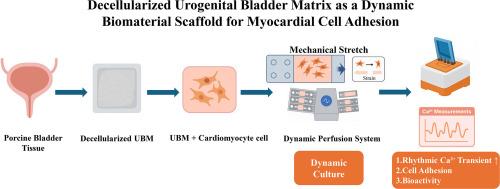Decellularized porcine urinary bladder matrix as a dynamic biomaterial scaffold for myocardial cell adhesion
IF 6.3
3区 工程技术
Q1 ENGINEERING, CHEMICAL
Journal of the Taiwan Institute of Chemical Engineers
Pub Date : 2025-09-02
DOI:10.1016/j.jtice.2025.106325
引用次数: 0
Abstract
Background
Porcine urinary bladder matrix (UBM) is a promising extracellular matrix-derived scaffold due to its excellent biocompatibility and structural integrity. Tissue engineering approaches for cardiac repair require scaffolds that promote myocardial cell adhesion and physiological function. This study investigates the potential of UBM as a dynamic culture scaffold for myocardial cell adhesion and activity.
Methods
UBM scaffolds were prepared by decellularizing porcine bladder tissue to remove cellular components while preserving the extracellular matrix. Cardiomyocytes were seeded onto the UBM scaffold and cultured under dynamic conditions using a custom-designed perfusion system to simulate physiological flow. Calcium ion activity was monitored to assess the functionality of myocardial cells.
Significant Findings
The decellularized UBM scaffold demonstrated high compatibility and supported adequate adhesion of myocardial cells under dynamic culture conditions. Although cardiomyocytes remained viable and adhered well to the scaffold, the calcium assay used in this study measured extracellular calcium levels in the supernatant and does not reflect intracellular calcium flux or contractile activity. Nonetheless, the sustained release of calcium ions from the UBM scaffold suggests bioactivity that may contribute to supporting cardiac tissue development.

脱细胞猪膀胱基质作为心肌细胞黏附的动态生物材料支架
猪膀胱基质(UBM)具有良好的生物相容性和结构完整性,是一种很有前途的细胞外基质衍生支架。心脏修复的组织工程方法需要促进心肌细胞粘附和生理功能的支架。本研究探讨了UBM作为心肌细胞粘附和活性的动态培养支架的潜力。方法对猪膀胱组织进行脱细胞处理,去除细胞成分,保留细胞外基质。将心肌细胞植入到UBM支架上,并使用定制的灌注系统在动态条件下培养以模拟生理流动。监测心肌细胞钙离子活性,评价心肌细胞功能。在动态培养条件下,脱细胞UBM支架具有较高的相容性,并支持心肌细胞的充分粘附。尽管心肌细胞仍能存活并与支架粘附良好,但本研究中使用的钙含量测定法测量的是上清液中的细胞外钙水平,并不能反映细胞内钙通量或收缩活性。尽管如此,钙离子从UBM支架的持续释放表明其生物活性可能有助于心脏组织的发育。
本文章由计算机程序翻译,如有差异,请以英文原文为准。
求助全文
约1分钟内获得全文
求助全文
来源期刊
CiteScore
9.10
自引率
14.00%
发文量
362
审稿时长
35 days
期刊介绍:
Journal of the Taiwan Institute of Chemical Engineers (formerly known as Journal of the Chinese Institute of Chemical Engineers) publishes original works, from fundamental principles to practical applications, in the broad field of chemical engineering with special focus on three aspects: Chemical and Biomolecular Science and Technology, Energy and Environmental Science and Technology, and Materials Science and Technology. Authors should choose for their manuscript an appropriate aspect section and a few related classifications when submitting to the journal online.

 求助内容:
求助内容: 应助结果提醒方式:
应助结果提醒方式:


